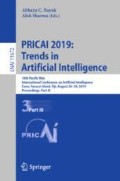Abstract
Recently, unidirectional convolutional neural networks have been widely used for salient object detection. However, most methods cannot solve common problems (i.e., the loss of valid information, tiny predicted feature, and isolated features in one block), which lead to inefficient feature reuse and blurred salient object edges. To address these problems, we propose a novel bi-directional features reuse network (BDFRN) for salient object detection, which consists of two subnets: forward-skip subnet and reverse-connect subnet. The forward-skip subnet employs an encoder-decoder structure to remedy the loss of salient details, and progressively refine the size of the predicted feature; meanwhile, the reverse-connect subnet can transmit the location features from top blocks to bottom blocks, such that these features can be reused and communicated between different blocks. Extensive experiments are conducted to demonstrate the performance of the proposed method, as compared with baseline methods.
Access this chapter
Tax calculation will be finalised at checkout
Purchases are for personal use only
References
Achanta, R., Hemami, S., Estrada, F., Susstrunk, S.: Frequency-tuned salient region detection. In: CVPR, pp. 1597–1604 (2009)
Chaurasia, A., Culurciello, E.: LinkNet: exploiting encoder representations for efficient semantic segmentation. In: VCIP, pp. 1–4 (2017)
Chen, S., Tan, X., Wang, B., Hu, X.: Reverse attention for salient object detection. In: Ferrari, V., Hebert, M., Sminchisescu, C., Weiss, Y. (eds.) ECCV 2018. LNCS, vol. 11213, pp. 236–252. Springer, Cham (2018). https://doi.org/10.1007/978-3-030-01240-3_15
Dabkowski, P., Gal, Y.: Real time image saliency for black box classifiers. In: ANIPS, pp. 6967–6976 (2017)
Einhäuser, W., König, P.: Does luminance-contrast contribute to a saliency map for overt visual attention? Eur. J. Neurosci. 17(5), 1089–1097 (2003)
He, K., Zhang, X., Ren, S., Sun, J.: Deep residual learning for image recognition. In: CVPR, pp. 770–778 (2016)
Hou, Q., Cheng, M.M., Hu, X., Borji, A., Tu, Z., Torr, P.: Deeply supervised salient object detection with short connections. In: CVPR, pp. 5300–5309 (2017)
Itti, L., Koch, C., Niebur, E.: A model of saliency-based visual attention for rapid scene analysis. IEEE Trans. Pattern Anal. Mach. Intell. 20(11), 1254–1259 (1998)
Li, G., Yu, Y.: Visual saliency based on multiscale deep features. In: CVPR, pp. 5455–5463 (2015)
Li, Y., Hou, X., Koch, C., Rehg, J.M., Yuille, A.L.: The secrets of salient object segmentation. In: CVPR, pp. 280–287 (2014)
Lin, T.Y., Goyal, P., Girshick, R., He, K., Dollár, P.: Focal loss for dense object detection. In: ICCV, pp. 2980–2988 (2017)
Liu, N., Han, J.: DHSNet: deep hierarchical saliency network for salient object detection. In: CVPR, pp. 678–686 (2016)
Liu, T., et al.: Learning to detect a salient object. PAMI 33(2), 353–367 (2011)
Long, J., Shelhamer, E., Darrell, T.: Fully convolutional networks for semantic segmentation. In: CVPR, pp. 3431–3440 (2015)
Martin, D., Fowlkes, C., Tal, D., Malik, J.: A database of human segmented natural images and its application to evaluating segmentation algorithms and measuring ecological statistics. In: ICCV, vol. 2, pp. 416–423 (2001)
Parkhurst, D., Law, K., Niebur, E.: Modeling the role of salience in the allocation of overt visual attention. Vis. Res. 42(1), 107–123 (2002)
Ronneberger, O., Fischer, P., Brox, T.: U-Net: convolutional networks for biomedical image segmentation. In: Navab, N., Hornegger, J., Wells, W.M., Frangi, A.F. (eds.) MICCAI 2015. LNCS, vol. 9351, pp. 234–241. Springer, Cham (2015). https://doi.org/10.1007/978-3-319-24574-4_28
Spain, M., Perona, P.: Measuring and predicting object importance. Int. J. Comput. Vis. 91(1), 59–76 (2011)
Wang, L., Lu, H., Ruan, X., Yang, M.H.: Deep networks for saliency detection via local estimation and global search. In: CVPR, pp. 3183–3192 (2015)
Wang, L., Wang, L., Lu, H., Zhang, P., Ruan, X.: Saliency detection with recurrent fully convolutional networks. In: Leibe, B., Matas, J., Sebe, N., Welling, M. (eds.) ECCV 2016. LNCS, vol. 9908, pp. 825–841. Springer, Cham (2016). https://doi.org/10.1007/978-3-319-46493-0_50
Yan, Q., Xu, L., Shi, J., Jia, J.: Hierarchical saliency detection. In: CVPR, pp. 1155–1162 (2013)
Zhang, P., Wang, D., Lu, H., Wang, H., Ruan, X.: Amulet: aggregating multi-level convolutional features for salient object detection. In: ICCV, pp. 202–211 (2017)
Zhao, R., Ouyang, W., Li, H., Wang, X.: Saliency detection by multi-context deep learning. In: CVPR, pp. 1265–1274 (2015)
Acknowledgment
This research is supported by Key Technology Program of Shenzhen, China (No. JSGG20170823152809704).
Author information
Authors and Affiliations
Corresponding author
Editor information
Editors and Affiliations
Rights and permissions
Copyright information
© 2019 Springer Nature Switzerland AG
About this paper
Cite this paper
Jia, F., Wang, X., Guan, J., Qi, S., Liao, Q., Li, H. (2019). Bi-directional Features Reuse Network for Salient Object Detection. In: Nayak, A., Sharma, A. (eds) PRICAI 2019: Trends in Artificial Intelligence. PRICAI 2019. Lecture Notes in Computer Science(), vol 11672. Springer, Cham. https://doi.org/10.1007/978-3-030-29894-4_3
Download citation
DOI: https://doi.org/10.1007/978-3-030-29894-4_3
Published:
Publisher Name: Springer, Cham
Print ISBN: 978-3-030-29893-7
Online ISBN: 978-3-030-29894-4
eBook Packages: Computer ScienceComputer Science (R0)

